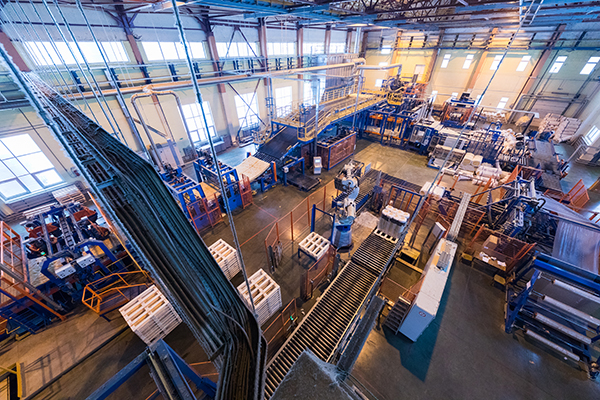From modernizing production to enhancing supply chain logistics, every aspect of operations presents an opportunity for optimization.

By: Kevin Rhode, Partner at The Bonadio Group
According to Federal Reserve Economic Data, labor productivity in the manufacturing industry has grown fairly stagnant over the last decade – a stark contrast to the 96% growth between 1987 and 2005. To make matters worse, the industry is facing a critical challenge in the form of widespread labor shortages. In fact, a recent study by Deloitte and The Manufacturing Institute found that the U.S. manufacturing industry could be faced with 2.1 million unfilled jobs by 2030.
Due to this, industry leaders must turn to new methods to maximize efficiencies and streamline their operations to support sustained success. From adopting new technologies to being more strategic in the approach to production, there are several methods to be explored to optimize workflow.
Below outlines the top six ways that leaders in manufacturing and distribution can increase their productivity and circumvent challenges associated with labor shortages.
Do you have strategic partnerships in place? Are you implementing forecasting techniques? If the answer to these questions is no, then there are certainly opportunities for you to optimize your supply chain.
A supply chain that runs efficiently is essential to ensure your production and distribution functions run smoothly. By leveraging strong relationships with suppliers, optimizing inventory levels, and embracing new technologies, manufacturers can overcome productivity challenges like long lead times and backlogs – improving supply chain resilience overall.
New technologies have created several opportunities for manufacturers to enhance visibility and traceability across their networks as well. These include Internet of Things (IoT) sensors, blockchain and artificial intelligence (A.I).
Given a lack of skilled workers, it’s critical to seek ways to automate simple and repetitive tasks so your employees can focus on more specialized work. Automation and robotics can increase the speed and accuracy of your production overall by relieving workers of mundane tasks while eliminating certain factors of human error.
In practice, integrating these technologies may include robotic assembly lines or automated inventory management systems that improve your output and product quality while utilizing fewer resources.
In this day and age, you no longer have to rely on instinct or subjectivity when it comes to making business decisions that will improve your operations. By embracing data analytics, manufacturers can be constantly monitoring the performance of various touchpoints throughout the manufacturing and distribution process. This allows for ease of identifying areas where there are bottlenecks, malfunctions, inefficiencies, or lack of performance that can be swiftly addressed and rectified.
Armed with this information, manufacturers can proactively adapt to changing market demands and operational challenges while decreasing the likelihood of costly production or supply chain disruptions.
Eliminate waste by adopting lean manufacturing principles using techniques like continuous improvement, stream mapping, and the 5S methodology – Sort, Straighten, Shine, Standardize, and Sustain. Doing so will significantly enhance your production efficiency and optimize workflows, while creating a culture of order.
Other benefits of adopting these principles include eliminating downtime and reducing inventory, which contribute to the lowering of overall operating costs.
Believe it or not, several operators are turning to producing goods to order to reduce excess inventory and storage costs. JIT manufacturing is the idea of producing goods as needed and in accordance with customer demand. This approach allows manufacturers to respond quickly to customer order fluctuations and reduce waste.
However, adopting this strategic approach requires a thorough supply chain management system and a close partnership with suppliers. Without these in place, JIT manufacturing can be hindered by the late delivery of components and materials.
In order to foster a strong culture of innovation and empowerment, employees much be properly trained in innovation and efficiency. This includes encouraging cross collaboration and equipping employees with the necessary knowledge, skills, and tools to identify opportunities for process improvement and creative solutions to optimize workflows.
For sustainability optimization, continuous performance monitoring is key. Establishing clear key performance indicators and setting regular performance reviews and process audits will ensure you maintain momentum.
Operational efficiency doesn’t happen overnight, but by embracing the above strategies, companies throughout the manufacturing and distribution industry can be one step closer to achieving decreased overhead and increased productivity while remaining competitive.

Kevin Rhode is a partner in the firm’s Assurance Practice. Kevin works closely with large-to-middle-market clients in various industries, including food and beverage, manufacturing, fuel and energy, service providers, and financial institutions. In addition, Kevin works with portfolio companies of private equity groups and entities with multi-national operations. His responsibilities include coordinating and managing financial statement audits and other attest services, including financial statement reviews, compilations, and agreed-upon procedures engagements. He has been a licensed CPA since 2011 and is a member of the American Institute of Certified Public Accountants. To learn more about The Bonadio Group, visit www.bonadio.com.
In this episode, I sat down with Beejan Giga, Director | Partner and Caleb Emerson, Senior Results Manager at Carpedia International. We discussed the insights behind their recent Industry Today article, “Thinking Three Moves Ahead” and together we explored how manufacturers can plan more strategically, align with their suppliers, and build the operational discipline needed to support intentional, sustainable growth. It was a conversation packed with practical perspectives on navigating a fast-changing industry landscape.